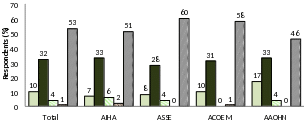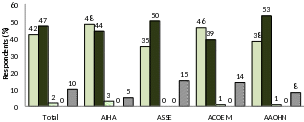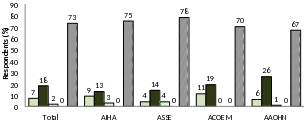NIOSH Customer Satisfaction Survey Follow-Up - Publication 2009 Battelle
Att. 7a CS Report 2009 Battelle.docx
Formative Studies on NIOSH Communications and Publications: NIOSH Customer Satisfaction Survey
NIOSH Customer Satisfaction Survey Follow-Up - Publication 2009 Battelle
OMB: 0920-0544
FINAL REPORT
Evaluation of Effectiveness of NIOSH Publications:
NIOSH Customer Satisfaction Follow-up Survey
October 15, 2010
Contract No. 200-2000-08018
Work Authorization No. 480100
Submitted to:
Vern Anderson, PhD
Technical Monitor
Centers for Disease Control and Prevention
Submitted by:
Lisa V. John, PhD, PMP
Jessica Banslaben, MSW
Betsy Payn, MA
Battelle
Centers for Public Health Research and Evaluation
10420 Old Olive Street Road, Suite 300
St. Louis, MO 63141-5939
ABSTRACT
The National Institute for Occupational Safety and Health (NIOSH) developed and conducted the NIOSH Customer Satisfaction Follow-up Survey in 2009-2010 as a follow-up to the 2003 baseline survey. The Follow-up Survey was designed to obtain current data on the impact and usefulness of NIOSH informational materials and outreach initiatives. The follow-up survey was implemented in partnership with the stakeholder organizations that participated in the baseline survey, namely the American Industrial Hygiene Association (AIHA), the American College of Occupational and Environmental Medicine (ACOEM), the American Association of Occupation Health Nurses (AAOHN), and the American Society of Safety Engineers (ASSE). The initial and follow-up mailings generated a return of 491 surveys, representing a response rate of 41%.
The majority of respondents worked in large organizations and performed a variety of occupational safety and health (OSH) activities. Eighty-two percent (82%) of respondents reported that they had ever used or referred to a NIOSH publication and 89% of these reported that their organization’s safety and health practices had been influenced a lot or a little by NIOSH publications. Most identified the Occupational Safety and Health Administration (OSHA) and NIOSH as primary sources of OSH information.
The vast majority of respondents (97%) who had used or referred to NIOSH materials in the past strongly agreed or agreed that NIOSH is an important resource for the OSH community and 100% strongly agreed or agreed that NIOSH is a credible source for obtaining OSH information. Most of these respondents also strongly agreed or agreed that NIOSH publications are up-todate, useful, impartial, and at the appropriate technical level. Among respondents who performed a variety of common OSH activities, more than 80% referred to NIOSH publications to perform these job duties during the past 12 months.
NIOSH continues to be perceived as a credible source for obtaining high-quality, usable OSH information. NIOSH publications are being utilized with increased frequency by respondents and their workplaces. Partnership initiatives have generally been well received and are perceived as strengthening NIOSH’s presence in the OSH community. Respondents are obtaining OSH information via electronic resources such as the NIOSH Web site more frequently than in 2003.
The results suggest that NIOSH could (1) partner with stakeholder associations/organization to perform a needs assessment of the members in the OSH community who are not using or referring to NIOSH resources, (2) develop strategies for further publicizing NORA, r2p, WorkLife, PtD, and eNews, (3) increase dissemination of materials through diverse stakeholder partners, (4) continue to develop electronic resources, and (5) continue to produce materials that provide practical and clear criteria documents and develop tools designed for direct application. As a cautionary note, the 59% of selected participants who did not respond to the survey may limit the ability to make inferences about the full population. Nonetheless, NIOSH can use these survey results to target ways for continuing to enhance awareness of its initiatives and improve the usefulness, relevance, and quality of its materials.
EXECUTIVE SUMMARY
For a nearly 40 year span, the National Institute for Occupational Safety and Health (NIOSH) has produced Policy Documents, Technical Documents, and Education Documents (collectively the NIOSH documents) in support of its mission to generate new knowledge in the field of occupational safety and health and to transfer that knowledge into practice1. In a given year, automatic mailings and responses to new requests for NIOSH publications can exceed 750,000 copies. In response to the vast dissemination of these publications, the NIOSH Customer Satisfaction Survey was developed and conducted in 2003. The goal of the 2003 baseline survey was to measure the dimensions of customer satisfaction for NIOSH publications and information delivery services.
The NIOSH Customer Satisfaction Follow-up Survey was designed to obtain current data on the impact of NIOSH informational materials and whether they are perceived as credible and useful by the occupational safety and health (OSH) community. It additionally serves as an important and valuable measure of the outreach initiatives generated as a result of the initial survey’s findings. The follow-up survey was designed to be similar to the baseline survey, but expanded and revised to reflect changes in NIOSH initiatives and technological advances. The follow-up survey was implemented in partnership with the same four major stakeholder organizations that participated in the baseline survey, including the American Industrial Hygiene Association (AIHA), the American College of Occupational and Environmental Medicine (ACOEM), the American Association of Occupation Health Nurses (AAOHN), and the American Society of Safety Engineers (ASSE).
The NIOSH Customer Satisfaction Follow-up Survey was 11 pages long and consisted of 28 questions presented in six sections: Background, Sources for OSH information, Opinions about NIOSH and its Communication Products, Preferences and Recommendations, NIOSH as a Research Partner, and a Final Comments open-ended portion. The survey was reviewed and approved for distribution by the Office of Management and Budget (OMB) through the end of April 2010. NIOSH mailed the survey in October 2009 to a random sample of 300 members from each of the four organizations, providing a combined sample size of 1,200. Participation was voluntary and all responses were anonymous. The initial and follow-up mailings generated a
return of 491 surveys, representing a combined response rate from the four associations of 41%
(491/1200)2.
Availability and Use of NIOSH Publications3 among all Survey Respondents
82% of the respondents answered yes when asked whether they had ever used or referred to a NIOSH publication; 18% answered no (Question 7).
76% of respondents identified the Occupational Safety and Health Administration
(OSHA) and 57% identified NIOSH as a primary source of OSH information (Question 6) when asked which three organizations provide the most important occupational safety and health (OSH) information for their job
Availability and Use of NIOSH Publications among Respondents Who Had Ever Used a NIOSH Publication4
65% of respondents had taken a course or educational program in which NIOSH publications were used informational materials either frequently (2%), occasionally (21%) or rarely (42%); 35% indicated they had not been used (Question 12e).
49% of respondents had used technical information in scientific journals, books or conference proceedings that were authored by NIOSH researchers/technical experts either frequently (14%) or occasionally (35%); 35% indicated that they used this information rarely, and 16% indicated they had not been used (Question 12f).
56% of respondents indicated that NIOSH publications had been referred to or cited by name in their organizations’ policies and procedures, whereas 25% indicated they had not been cited, 17% did not know, and 3% chose did not apply (Question 8).
89% of the respondents indicated that their organization’s safety health practices had been influenced by NIOSH publications either a lot (44%) or a little (45%), whereas 3% indicated not at all and 8% did not know (Question 9).
79% of the respondents indicated that they had recommended to a colleague one or more NIOSH information or communication products either frequently (9%), occasionally (33%), or rarely (37%) (Question 12d).
NIOSH as an Information Source
100% of the respondents who used or referred to NIOSH materials either strongly agreed (73%) or agreed (27%) with the statement that NIOSH is a credible source for obtaining OSH information (Question 14a).
97% of the respondents who used or referred to NIOSH materials either strongly agreed (57%) or agreed (40%) with the statement that NIOSH is an important resource for the OSH community; 2% disagreed or strongly disagreed) and 2% had no opinion (Question 14f).
88% of the respondents who used or referred to NIOSH materials either strongly agreed or agreed with survey statements that characterized NIOSH publications as containing up-to-date information (88%), impartial information (81%), information at the appropriate technical level (91%), and useful recommendations (96%) (Questions 16 a, b, c, e).
60% of the respondents who used or referred to NIOSH materials reported using NIOSH printed publications either frequently (20%) or occasionally (40%) in the past 12 months (Question 12a). 74% of the respondents reported accessing the NIOSH Web site either frequently (34%) or occasionally (40%) in the past 12 months (Question 12b).
Use and Types of NIOSH Publications
Among respondents who identified the following tasks as among their primary job responsibilities, more than 80% referred to NIOSH publications to perform these job duties during the past 12 months (Question 13):
Assessing workplace safety and health exposure conditions (85%) o Formulating new/revised safety and health policies/practices (84%) o Developing/conducting research projects (83%) o Conducting occupational safety and health training (82%)
Establishing and/or maintaining occupational safety and health programs (81%)
Respondents who used or referred to NIOSH materials considered a list of suggestions for improving NIOSH dissemination and placed the highest value (1 or 2 on a 5-point scale) on the following items (Question 16 a, b, d, f):
Package/distribute NIOSH publications around common themes (84%)
Publicize and increase the circulation of NIOSH Health Hazard Evaluation (HHE)
Reports (72%) o Increase dissemination through alliances with partners such as industry, labor, professional associations, trade associations, academia, and other (64%) o Support a blog on the NIOSH Web site to discuss current science issues (26%)
Respondents who used or referred to NIOSH materials identified their top three choices of publications that NIOSH should consider emphasizing in the future. The topics list below reflects a combined percentage of an item being ranked 1, 2, or 3, beginning with the most popular choice (Question 18):
Practical applications and guides (checklists, how-to publications, self-audits)
(62%) o Recommended safety and health standards (criteria documents) (55%) o Booklets or documents for educating and informing workers (38%) o Booklets or documents for educating and informing owners and managers (29%) o Case studies (Health Hazard Evaluations and fatality investigations)(26%) o Scientific/technical documents (22%) o Manual of Analytical Methods (13%)
CONCLUSIONS
NIOSH publications and information services continue to be viewed favorably in the OSH community, with some marked improvements and some areas that deserve additional attention:
NIOSH continues to be perceived as a credible source for obtaining OSH information that provides high-quality, usable information. Slight increases were seen in support of this statement which can most likely be attributed to initiatives and outreach efforts.
Survey responses indicate that NIOSH publications are being utilized with more frequency by respondents and their workplaces. The health services sector continues to report the lowest usage rate.
Partnership initiatives NIOSH has created have generally been well received and are perceived as strengthening NIOSH’s presence in the OSH community.
Respondents continue to support the statement that NIOSH is an important resource for the OSH community, although there was a slight decrease in respondents strongly agreeing with this statement.
Respondents are relying on electronic resources and using the NIOSH Web site more frequently than in 2003 to obtain OSH information.
NIOSH information and training were generally endorsed as contributing to the effectiveness of individuals’ professional practice as well as organizational safety and health practices.
RECOMMENDATIONS
Partner with stakeholder associations/organization to identify and perform a needs assessment of the members in the OSH community who are not using or referring to NIOSH resources, with a focus towards members of the health services sector.
Develop strategies for publicizing and disseminating partnership initiatives to those in the OSH community who are still unaware of initiatives such as NORA, r2p, WorkLife, and PtD. Special consideration should be given to examining the lack of awareness of NORA.
Develop approaches to increase awareness of eNews within the OSH community.
Disseminate more frequently through diverse stakeholder partners and continue to develop electronic resources as a means of communication to the OSH community.
Generate research on workplace exposure and disease, identifying early indicators of work-related disease, identifying controls for various exposures, and ergonomics.
Continue to produce materials that provide practical and clear guidance on matters related to policy (i.e. criteria documents) and develop tools designed and packaged for more direct application.
TABLE OF CONTENTS
ABSTRACT................................................................................................................................................... II
EXECUTIVE SUMMARY............................................................................................................................. III
ABBREVIATIONS....................................................................................................................................... XI
ACKNOWLEDGEMENTS........................................................................................................................... XII 1. INTRODUCTION TO THE STUDY........................................................................................................... 1
SURVEY SECTION I: BACKGROUND OF RESPONDENT 7
SURVEY SECTION II: RESPONDENTS’ SOURCES FOR OSH INFORMATION 8
Printed, Electronic, and Interpersonal Sources (Question 5) 8
Most Important OSH Information Organization Sources (Question 6) 9
Accessing NIOSH Information (Question 7) 10
NIOSH OSH Information Referred in Organization Policy and Procedures (Question 8) 10
NIOSH and Organizations’ Safety and Health Practices (Question 9) 11
Quality of NIOSH Information for Organization and Professional Practice (Questions 10 and 11) 12
Determining How Frequently NIOSH Publications and its Web Site are Used (Question 12) 13
Primary Job Responsibilities for Respondents (Question 13) 17
SECTION III: OPINIONS ABOUT NIOSH AND ITS COMMUNICATION PRODUCTS 19
SECTION IV: RESPONDENT PREFERENCES AND RECOMMENDATIONS 24
Respondent Preference for Obtaining NIOSH Information (Question 15) 24
New Safety and Health Topics for Future NIOSH Publications (Question 17) 30
Types of NIOSH Publications (Question 18) 31
Occupational and Health Research Topics for NIOSH in the Future (Question 19) 31
Occupational Safety and Health Problems Requiring Research (Question 20) 31
SECTION V: NIOSH AS A RESEARCH PARTNER 32
Awareness and Importance of NIOSH Partnership Initiatives (Questions 21, 22, 23, and 24) 32
Impact of NIOSH Partnerships on Occupational Safety and Health Community (Question 25) 33
New Topic Areas or OSH Initiatives for NIOSH Initiatives (Question 26) 33
Stakeholder for NIOSH Initiatives (Question 27) 34
LIST OF FIGURES
Figure 1 Question 7: Percentage of respondents who have ever read or referred to a NIOSH
publication, by association .......................................................................................................... 10
Figure 2 Question 8: Percentage of respondents reporting that NIOSH publications were
referred to or cited by name in their organization's policies and procedures ............................. 11
Figure 3 Question 9: Percentage of respondents reporting that their organization's OSH
practices have been influenced by NIOSH publications, by association .................................... 12
Figure 4 Question 12a: Frequency with which respondents used NIOSH printed publications to
find OSH information .................................................................................................................. 14
Figure 5 Question 12b: Frequency with which respondents accessed the NIOSH Web site to find
OSH information ......................................................................................................................... 14
Figure 6 Question 12c: Frequency with which respondents have opened or downloaded the
NIOSH e-News ........................................................................................................................... 15
Figure 7 Question 12d: Frequency with which respondents have recommended NIOSH
publications to a colleague ......................................................................................................... 15
Figure 8 Question 12e: Frequency with which respondents have taken an educational/training
program in which NIOSH publications were used ...................................................................... 16
Figure 9 Question 12f: Frequency with which respondents have used technical information in scientific journals, books or conference proceedings that was authored by NIOSH
researchers ................................................................................................................................. 16
Figure 10 Question 13: Percentage of respondents reporting if they referred to NIOSH
publications to do tasks .............................................................................................................. 18
Figure 11 Question 14a: Percentage of respondents who agreed that NIOSH is a credible source
for obtaining OSH information, by association ........................................................................... 20
Figure 12 Question 14b: Percentage of respondents who agreed that NIOSH eNews keeps them
informed about OSH current events, by association .................................................................. 20
Figure 13 Question 14c: Percentage of respondents who agreed that the NIOSH Web site
contains high quality, usable information, by association ........................................................... 21
Figure 14 Question 14d: Percentage of respondents who agreed that the NIOSH/CDC 800-
Number provides high quality, usable information, by association ............................................. 21
Figure 15 Question 14e: Percentage of respondents who agreed that NIOSH exhibits at conferences keep them informed about new publications/services, by association .................. 22
Figure 16 Question 14f: Percentage of respondents who agreed that NIOSH is an important
resource for the OSH community, by association ...................................................................... 22
Figure 17 Questions 14g-14j: Percentage of respondents who agreed or disagreed with various
descriptions of NIOSH publications ............................................................................................ 23 Figure 18 Question 15a: Request and/or download from NIOSH Web site ............................................... 24
Figure 19 Question 15b: Call NIOSH/CDC 800-Number ............................................................................ 24 Figure 20 Question 15d: Request at NIOSH conferences or exhibit .......................................................... 25
Figure 21 Question 15: Preferences for obtaining NIOSH information ....................................................... 25 Figure 22 Question 16a: Publicize and increase the circulation of NIOSH Health Hazard
Evaluation Reports...................................................................................................................... 27
Figure 23 Question 16b: Package and distribute NIOSH publications around common themes
(e.g., noise and hearing loss, ergonomics, agriculture) .............................................................. 27
Figure 24 Question 16c: Make publications available in different languages ............................................. 28
LIST OF TABLES
Table 1. Follow-Up Survey Contents and Associated Questions ............................................................... 3 Table 2. 2003 Baseline Survey Participation Information by Association .................................................. 4
Table 3. Follow-Up Survey Participation Information by Association ......................................................... 5
Table 4. Mailed and Web Survey Returns .................................................................................................. 7
Table 5. Background of Respondents ........................................................................................................ 7
Table 6. Question 5: Frequency of Using Printed, Electronic, and Interpersonal Sources for Finding
OSH Information ........................................................................................................................... 8
Table 7. Question 6: Associations to Which Respondents Look for OSH Information ............................... 9
Table 8. Question 10 and 11: Quality of NIOSH Information and/or Training as it Contributes to
Effectiveness ............................................................................................................................... 12
Table 9. Question 12: Frequency of Performing the Following Tasks Within the Past 12 Months .......... 13
Table 10. Question 13: Primary Job Responsibilities of Respondents and Referring to NIOSH as a
Source of Information ................................................................................................................. 17
Table 11. Question 14: Opinions About NIOSH and its Communication Products .................................... 18
Table 12. Question 15: Preferred Methods of Obtaining NIOSH Information ............................................ 23
Table 13. Question 16: Methods to Improve NIOSH Dissemination of Information ................................... 26
Table 14. Question 17: Safety and Health Topics to Include in Future NIOSH Publications ..................... 28
Table 15. Question 18: Types of Publications NIOSH Should Emphasize in the Future ........................... 29
Table 16. Question 19: Occupational and Health Research Topics for Future Focus ............................... 29
Table 17. Question 20: Occupational Safety and Health Problems Requiring More Research ................. 30
Table 18. Questions 21-24: Awareness and Importance of Four New NIOSH Initiatives .......................... 30
Table 19. Question 26: Topics Areas that Should be Included in NIOSH Initiatives .................................. 31 Table 20. Question 27: Stakeholders NIOSH Should Partner with Through Their Initiatives .................... 32
ABBREVIATIONS
AAOHN American Association of Occupational Health Nurses
ACGIH American Conference of Governmental Industrial Hygienists
ACOEM American College of Occupational and Environmental Medicine
AIHA American Industrial Hygiene Association
ANSI American National Standards Institute
ASSE American Society of Safety Engineers
CDC Centers for Disease Control and Prevention
CSP Certified Safety Professional EPA U.S. Environmental Protection Agency
FACE Fatality Assessment and Control Evaluation
GAO Government Accounting Office
GPRA Government Performance and Results Act
HHE Health Hazard Evaluation
IH Industrial Hygienist
MRQs Multiple Response Questions
NIOSH National Institute for Occupational Safety and Health
NORA National Opinion Research Agenda
OCR Optical Character Recognition
OMB Office of Management and Budget
OSH Occupational Safety and Health
OSHA Occupational Safety and Health Administration PtD Prevention through Design QA/QC Quality Assurance/Quality Control r2p Research to Practice
ACKNOWLEDGEMENTS
Battelle would like to thank the many people who contributed to the success of this project. We especially express our gratitude for the support of Dr. Vern Anderson, Health Scientist, Education and Information Division, the Technical Monitor for this project. This project would not have been possible without the participation and continual support of the American Association of Occupational Health Nurses (AAOHN), the American College of Occupational and Environmental Medicine (ACOEM), the American Industrial Hygiene Association (AIHA), and the American Society of Safety Engineers (ASSE). Finally, we gratefully acknowledge the Occupational Safety and Health community members who participated in this survey and shared their valuable feedback and opinions.
1. INTRODUCTION TO THE STUDY
The National Institute for Occupational Safety and Health (NIOSH) developed a NIOSH Customer Satisfaction Survey in 2003 to measure the dimensions of customer satisfaction for its publications and information delivery services. The 2003 baseline survey was designed in response to Executive Order 12862, Setting Customer Service Standards, which requires Federal agencies to provide the highest quality service to the American people. The Customer Satisfaction Survey was referenced in the 1999 Government Accounting Office (GAO) report, Selected Approaches for Verification and Validation of Agency Performance Information, as a valid and reliable measure to meet requirements of the Government Performance and Results Act (GPRA). As mandated in the Occupational Safety and Health Act of 1970 (PL 91–596), the mission of NIOSH is to conduct research and investigations on work-related disease and injury and to disseminate information for preventing identified workplace hazards [Sections 20 (a) (1) and (d)]. This dual responsibility recognizes the need to translate research into workplace application to impact worker safety and well-being. Specifically, NIOSH, through communication efforts, seeks to promote greater awareness of occupational hazards and their control, influence public policy and regulatory action, shape national research priorities, change organizational practices and individual behavior, and ultimately, improve American working life. Although the means for packaging and delivering NIOSH-generated information varies, one of the primary communication vehicles is its series of numbered print publications. For the years 2002 through 2007, NIOSH prepared approximately 300 numbered publications for distribution. Reflecting the need to address different issues and target audiences, these publications are catalogued by NIOSH as Policy Documents, Technical Documents, and Educational Documents.
The NIOSH documents are made available to the public through the use of mailing lists of known interested parties, NIOSH e-News, home page announcements on the NIOSH website, promotion at conferences, and other means. In a given year, automatic mailings and responses to new requests for NIOSH publications can exceed 750,000 copies. Yet, these numbers tell little of whether the reports are reaching all of the appropriate audiences, or more importantly, whether the information is perceived as credible and useful by the recipients. Therefore, the baseline survey was conducted in 2003 with four major associations identified with occupational safety and health matters to assess customer satisfaction. These associations were the American Industrial Hygiene Association (AIHA), the American College of Occupational and
Environmental Medicine (ACOEM), the American Association of Occupational Health Nurses (AAOHN), and the American Society of Safety Engineers (ASSE). The results from the baseline survey indicated that NIOSH could (1) expand its outreach to the 20% to 25% of professionals who had not used NIOSH materials, (2) produce more publications that provide examples of how to implement and evaluate safety and health improvements, and (3) increase outreach efforts to better serve the occupational health service sectors, such as the occupational nurses and occupational physicians.
The results from the NIOSH baseline customer satisfaction survey also served to guide continuing efforts to improve the usefulness, relevance, and quality of NIOSH publications and outreach efforts. As a result of the 2003 baseline survey NIOSH instituted several important changes in its distribution and outreach approaches. These changes included a concerted effort to remedy the apparent lack of awareness and usage of NIOSH communication products among the
membership of AAOHN and ACOEM (e.g., encourage members to subscribe to the NIOSH newsletter, meetings with the associations’ leadership), launch of a monthly electronic newsletter called e-News, revision of the NIOSH website, and adopting an industry sector approach.
The current study seeks to update the data collected in 2003 and gather data on outreach initiatives NIOSH has undertaken in recent years. This survey is an effort by the agency to obtain current estimates of consumer use/benefit from NIOSH communication products as a whole, as well as to determine the adequacy of the agency’s circulation/delivery practices in light of changing distribution approaches and technologies. The survey was directed to members of the four occupational safety and health (OSH) professional organizations that partnered with NIOSH for the baseline survey.
The NIOSH Customer Satisfaction Survey follow-up was designed to determine (1) to what extent NIOSH publications are perceived as credible, useful sources of information on occupational safety and health issues, (2) whether NIOSH is successful in distributing its communication products to its primary and traditional audience, (3) to what extent (and in what ways) NIOSH communication products have influenced workplace safety and health program policies and practices, (4) the improvements that could be made in the nature of NIOSH communication products and/or their manner of delivery that could enhance use and benefit, and (5) the reach and perceived importance of NIOSH outreach initiatives. The project aim was to determine the extent to which NIOSH has been successful in meeting its goals and improving its outreach to these OSH practitioners and assess the current level of customer satisfaction.
The purpose of this report is to (1) describe the process for developing and administering the NIOSH Customer Satisfaction Follow-up Survey, (2) report the findings from the follow-up survey, and (3) consider the implications for future action. The results will be used by those involved in preparing and disseminating various types of NIOSH documents to aid in future writing and distribution efforts.
In addition, the survey results will be shared with the partner associations—namely, the
American Association of Occupational Health Nurses (AAOHN), the American College of Occupational and Environmental Medicine (ACOEM), the American Industrial Hygiene Association (AIHA), and the American Society of Safety Engineers (ASSE). The outcomes of the survey hold important benefits to the associations’ individual members. Specifically, each association will learn more about their members’ work activities, organizations for which they work, years of experience, education, sources of OSH information, and training needs. In turn, the associations can form alliances with NIOSH to participate in NIOSH strategic planning to assure NIOSH is meeting their needs for protecting workers.
2. METHODS OF RESEARCH
SURVEY REVISION
The follow-up survey was designed to be similar to the baseline survey, but expanded and revised to reflect changes in NIOSH initiatives and technological advances. A Certified Industrial Hygienist (IH) from Battelle who is a member of the AIHA and the ASSE assisted with the refinement of the questionnaire items based on experience with a diverse range of industries, organizations and government entities, such as the chemical industry, the automotive and shipbuilding industries, and the Department of Energy. The IH also obtained suggestions from several occupational physicians regarding the content of the questionnaire. The final draft was reviewed by 8 pilot test participants representing the four target professions. These individuals completed the draft survey and provided further recommendations regarding wording and content, with a particular focus on the new questions that were added to address research partnerships and occupational medicine.
SURVEY CONTENT
The NIOSH Customer Satisfaction Survey Follow-up consisted of six sections, as outlined in Table 1. The report of the findings from the follow-up survey is organized by section. The survey was mailed with two NIOSH CD-ROM products containing a variety of databases and information sources dealing with significant occupational safety and health issues.
Table 1. Follow-up Survey Contents and Associated Questions
Section |
Content |
Question Numbers |
I |
Background – tell us about yourself |
1-4 |
II |
Your sources for OSH information |
5-13 |
III |
Your opinions about NIOSH and its communication products |
14 |
IV |
Your preferences and recommendations |
15-20 |
V |
NIOSH as a research partner |
21-27 |
VI |
Final comments |
28 |
*Question 7 served as a branching question that skipped to Section V when answered no.
SAMPLING METHODS
Population
The target audience consisted of OSH professionals who belonged to one or more of the four primary professional organizations: AAOHN (10,000 members), ACOEM (4,952 members), AIHA (10,600 members), and ASSE (32,000 members). Of the largest group (ASSE), only a segment identified as Certified Safety Professionals (CSPs, N=7,543) were included in the target population because of the type of work they did. As a result of the members’ professional affiliations and status, the final target population of about 33,000 was considered for this survey to represent a relatively homogeneous population.
Sample Size
Since the analysis of the results of the questionnaire consist of descriptive statistics, the sample size was designed to produce summary measures estimated with a specified level of precision. Most of the summary statistics are proportions, e.g. proportion of respondents who have taken a course/internet seminar or attended an education/training program in which NIOSH publications were used. The total sample size of 1200 individuals was expected to yield 720 completed questionnaires, designed to produce 95% confidence intervals that are + 3.5 %.
Response Rate
The 2003 baseline survey resulted in an overall response rate of approximately 57%. Table 2 shows the response rate by association for the 2003 survey.
Table 2. 2003 Baseline Survey Participation Information by Association
Survey Item |
AIHA |
ASSE |
ACOEM |
AAOHN |
Total |
Number of surveys mailed |
300 |
300 |
300 |
300 |
1,200 |
Number of surveys returned |
194 |
180 |
148 |
166 |
688 |
Participation rate (%)* |
64 |
60 |
49 |
55 |
57 |
Affiliation response rate (%)† |
28 |
26 |
22 |
24 |
100 |
*Rate = surveys returned/surveys mailed †Rate = surveys returned by association/688
Based on the results of the baseline survey and considering protocol improvements designed to improve response rates, it was expected that 720 (60%) would complete a follow-up survey within the data collection period. Based on the results of the baseline survey, we anticipated that approximately 12% of the total responders would fill out their survey online with the remaining 88% completing a paper version. NIOSH followed several recommendations for improving response rates, including letters from the four partner associations, two NIOSH CD-ROM products sent in the first mailing as an incentive, salient survey topic, option of completing the survey electronically via the web5, and follow-up mailings at appropriate intervals6.
Distribution Size
Since the satisfaction of each of the four professions is of equal importance to NIOSH, the designated total sample size of 1200 was composed of an equal number of persons (300) drawn at random from each of the four associations. Equal sample sizes for each group were chosen because comparisons and estimates for subgroups were judged to be very important and equal allocation would optimize this objective, i.e. provide the greatest power. To select the random sample for each of the four associations, random number was generated for each record on a membership roster. The membership roster was sorted according to the assigned random numbers, and the first 300 records on the list were the sample for that roster. If a letter was returned undeliverable, the next record on the list was used to replace the undeliverable record.
The final sample was screened to ensure that persons having multiple association memberships were selected once and assigned to the group most aligned with their professional training based on the title listed on their membership address. NIOSH employees who are members of the four associations were excluded from the membership listing before the sample was drawn. An electronic version of the questionnaire was developed, giving respondents the option to complete the survey anonymously via a secure website. Table 3 provides a summary of the sample for the follow-up survey, segmented by professional association.
Table 3. Follow-up Survey Participation Information by Association
Survey Item |
AIHA |
ASSE |
ACOEM |
AAOHN |
Total |
Population size |
10,600 |
7,543* |
4,952 |
10,000 |
33,095 |
Number of surveys mailed |
300 |
300 |
300 |
300 |
1,200 |
Number of surveys returned |
144 |
121 |
103 |
123 |
491 |
Participation rate (%)† |
48 |
40 |
34 |
41 |
41 |
Affiliation response rate (%)†† |
29 |
25 |
21 |
25 |
100 |
* The sample from ASSE consisted of the ~7,500 Certified Safety Professionals.
† Rate = surveys returned/surveys mailed ††Rate = surveys returned by association/491
Survey Mailing
The initial mailing (October 13, 2009) contained a personalized introduction letter from Battelle, a generic cover letter from one of the four OSH professional associations, personalized survey response card, user name/password insert for the web survey option, and two NIOSH CD ROMs as a token appreciation item. A reminder postcard was sent to all sample members approximately two weeks after the initial mailing. These initial mailings resulted in a response rate of 16% completed via the web. On November 12, 2009 a follow-up packet containing a hardcopy survey and the web option was mailed to non-responders, bringing the response rate to 30%. Another follow-up packet with sent to non-responders on February 16, 2010. This final follow-up packet was mailed using a NIOSH outgoing envelope, instead of a Battelle envelope, to assist with increasing response rates. This mailing was followed by a final reminder postcard. The final follow-up mailing and reminder postcard yielded another 11% for a total response rate of 41% by the end of April, 2010.
DATA ANALYSIS PLAN
Organization
This report is organized to present the findings of the survey as percentages. For a specific question or subquestion, the data consist of the sum of the response frequencies divided by the number of respondents answering that question to form percentages. The percentages are shown in the tables, figures, and text of this report. Where respondents had only a single choice, the sum of the response frequency equals 100% (small rounding variations can occur).
To enhance the informational value from individual questions, the data also were broken down or organized by the association with which each respondent was affiliated. Since each survey was printed with a unique control number that tracked affiliation membership, both survey distribution and association membership were controlled. The affiliation designator provided a convenient way to organize the data according to professional training and job
responsibilities/activities. The same computational rules were followed for the questions where separate organizational affiliation data were shown. The tables and figures in this report provide the frequency of the response as a percentage for the question. For the combined respondent sample, the label designator Total All is used in the figures. The figure labels for each of the four associations are AIHA, ASSE, ACOEM, and AAOHN.
A number of questions instructed the respondents to mark all answers from a supplied list that was applicable. Questions with multiple responses were treated as independent questions, each requiring a yes or no response. For each survey question allowing multiple responses, the frequency of yes responses for each choice was counted and converted to a percentage.
Data Quality Procedures
Quality control procedures were incorporated into the data processing system through the use of TeleForm®, a system which provides advanced optical character recognition (OCR) and throughput capabilities with accuracy rates approaching 100%. Battelle developed robust forms that included range checks, skip pattern checks, and cross checks that were applied when scanning and verifying forms. In addition, Visual Basic scripts were included in the web e-pdfs to incorporate quality assurance/quality control (QA/QC) features.
SURVEY PROCEDURE
The NIOSH Customer Satisfaction Survey Follow-up, consisting of 28 questions, was reviewed and approved for distribution by OMB until April 30, 2010 (OMB No. 0920-0544). The printed survey was 11 pages long, including the cover and instructions. A number of questions had multiple parts, required multiple responses, and provided opportunities for written comments. Depending on the respondent’s familiarity with and use of NIOSH services and information, the survey could be completed in 6 to 25 minutes.
NIOSH mailed the survey to a random sample of 300 members from each of the four organizations, providing a combined sample size of 1,200. Participation was voluntary and all responses were anonymous. All participants were instructed to complete the first 7 questions of the survey. The initial 6 questions were designed to gauge the type of work of the respondents and organizational source and frequency of accessing OSH information for work. Question 7 asked specifically about NIOSH as a source of information for the respondent. If the respondent indicated that he or she had never used or referred to a NIOSH publication (including NIOSH printed materials, NIOSH Web site materials, or information from the NIOSH 800-Number), the respondent was instructed to skip to Section V of the survey. A self-addressed, prepaid return envelope was enclosed for completed hardcopy surveys to be returned to Battelle.
Table 4. Mailed and Web Survey Returns
Group |
Web |
Hard Copy |
Total |
% |
AAOHN |
60 |
63 |
123 |
41% |
ACOEM |
50 |
53 |
103 |
34% |
AIHA |
100 |
44 |
144 |
48% |
ASSE |
78 |
43 |
121 |
40% |
Total |
288 |
203 |
491 |
41% |
3. SURVEY RESEARCH FINDINGS
SURVEY SECTION I: BACKGROUND OF RESPONDENT
Table 5 summarizes the current data from four separate survey questions related to the respondent’s training and job (Questions 1, 2, 3, and 4) and compares them to the baseline data, when applicable. The tables show that a diverse group of people from various professional backgrounds responded to the survey. More Industrial Hygienists responded to the survey than those from other backgrounds, but not by large margins. Of those who selected the “other” category, several reported they were nurse practitioners, physician assistants, chemists, toxicologist, or engineer, but the large majority of them classified themselves as a safety manager or professional (environmental, industrial, or occupational). A large percentage of respondents worked for a company or a business (44%) and a majority worked for a large organization (66%). Nearly half reported that they worked in manufacturing (48%).
Table 5. Background of Respondents
Question 1: Professional training/background of respondents |
% Respondents |
|
2009 |
2003 |
|
Physician |
20 |
18 |
Industrial safety engineer* |
19 |
31 |
Nurse |
24 |
25 |
Industrial hygienist |
28 |
31 |
Other** |
16 |
37 |
Question 2: Type of organization of respondents’ employment |
2009 |
2003 |
Company/business |
44 |
43 |
Labor organization |
0 |
0 |
Industry or trade association |
3 |
10 |
Hospital/clinic |
19 |
19 |
Private consultant |
14 |
13 |
Professional society staff |
0 |
0 |
Federal/State/Local government agency |
13 |
14 |
Other |
12 |
15 |
Question 3: Size of respondents’ organizations |
2009 |
2003 |
Self only |
8 |
5 |
Small (less than 100 employees) |
14 |
14 |
Medium (101 to 500 employees) |
12 |
14 |
Large (more than 500 employees) |
66 |
67 |
Question 4: Type of sectors in which respondents’ work and apply professional skills |
2009 |
|
Agriculture, forestry, and fishing |
8 |
|
Construction |
30 |
|
Healthcare and social assistance |
41 |
|
Mining/Oil and gas extraction |
12 |
|
Manufacturing |
48 |
|
Services |
27 |
|
Transportation, warehousing, and utilities |
30 |
|
Wholesale and retail trade |
13 |
|
Other |
23 |
|
* 2003 percentage based on closest available profession, Safety professional/manager.
** 2003 percentage is a combination of baseline survey’s “other” category and additional professions listed that were not included in 2009 survey.
SURVEY SECTION II: RESPONDENTS’ SOURCES FOR OSH INFORMATION
Printed, Electronic, and Interpersonal Sources (Question 5)
Respondents were asked how often (as measured in terms of daily, weekly, monthly, and less than monthly) they used printed, electronic, and interpersonal sources of OSH information. Printed sources included traditional books, journals, and technical reports. Electronic sources included the Web, CD-ROMS, and software. Interpersonal sources included colleagues, experts, and information from attending conferences. This question was aimed at determining preferences and usage for accessing OSH information. Table 6 displays current data, which are compared to 2003 data, when applicable. As might be expected with increased dependence on electronic resources, respondents relied more on electronic sources for OSH information on a daily basis (+9%) and printed sources decrease usage on a daily basis (+15%) as compared to the baseline survey. Interestingly, participants also increased their daily and weekly usage (+11%) of interpersonal sources, such as colleagues, experts, meetings, and conferences, since the baseline survey.
Table 6. Question 5: Frequency of Using Printed, Electronic, and Interpersonal Sources for Finding OSH Information
Frequency |
% Respondents |
|
Printed sources: |
2009 |
2003 |
Daily |
19 |
34 |
Weekly |
36 |
39 |
Monthly |
25 |
21 |
Less than monthly |
21 |
5 |
|
|
|
Frequency |
% Respondents |
|
Electronic sources: |
2009 |
2003 |
Daily |
50 |
41 |
Weekly |
30 |
38 |
Monthly |
14 |
14 |
Less than monthly |
7 |
7 |
|
|
|
Interpersonal sources: |
2009 |
2003 |
Daily |
30 |
22 |
Weekly |
33 |
30 |
Monthly |
23 |
26 |
Less than monthly |
14 |
22 |
Most Important OSH Information Organization Sources (Question 6)
Respondents were provided with a list of 15 organizations that serve as sources of OSH information. Question 6 asked which three organizations from the list provide the most important OSH information (via the web or printed) for the respondent’s job. Since multiple responses were allowed, the data in Table 7 are best interpreted as a rank order score. The results indicate that OSHA and NIOSH continue to be leading sources of OSH information for the respondents. Overall decreased percentages could be attributed to altered answer format.
Table 7. Question 6: Associations to Which Respondents Look for OSH Information
Association |
% Respondents* |
|
|
2009 |
2003 |
OSHA Occupational Safety and Health Administration |
76 |
84 |
NIOSH National Institute for Occupational Safety and Health |
57 |
74 |
AAOHN American Association of Occupation Health Nurses |
24 |
30 |
ACOEM American College of Occupational and Environmental Medicine |
21 |
32 |
ACGIH American Conference of Governmental Industrial Hygienist |
17 |
45 |
ASSE American Society of Safety Engineers |
17 |
40 |
AIHA American Industrial Hygiene Association |
16 |
44 |
ANSI American National Standards Institute |
13 |
46 |
NFPA National Fire Protection Agency |
12 |
39 |
Commercial Newsletters |
10 |
33 |
EPA Environmental Protection Agency |
9 |
44 |
ATSDR Agency for Toxic Substances and Disease Registry |
7 |
22 |
NSC National Safety Council |
4 |
30 |
Trade Organizations |
3 |
15 |
Labor Organizations |
0 |
8 |
* 2003 question only allowed for the respondent to select three organizations, whereas 2009 question allowed unlimited selection of organizations.
Accessing NIOSH Information (Question 7)
Question 7 was designed to separate practitioners who had used or referred to NIOSH publications from those who had never used NIOSH information products. As shown in Figure 1, the results indicated that 18% of the respondents had not used NIOSH information. Since those respondents would not be familiar with NIOSH information products, they were directed to skip to Section V of the survey. Of the 491 responders, 18% responded no, representing a 3% increase in usage or reference to NIOSH materials as compared to the baseline survey. The remaining 82% indicated that they had used or referred to NIOSH information (that is, printed publications, the Web site, and the 800-Number), and therefore were instructed to continue with the next question. Within associations, the two medical associations (ACOEM and AAOHN) continue to utilize NIOSH materials the least, as was also indicated in the baseline survey.
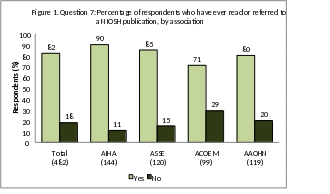
NIOSH OSH Information Referred in Organization Policy and Procedures (Question 8)
Respondents were asked if NIOSH OSH information, either from NIOSH documents or the web site, has been referred to or cited by name in their organization’s policy and procedures. As depicted in Figure 2, more than half of the respondent (56%) reported that their organization referred to NIOSH documents or the web site in its policies and procedures. This represents a 7% percent increase from the baseline survey. Figure 2 depicts responses by association.
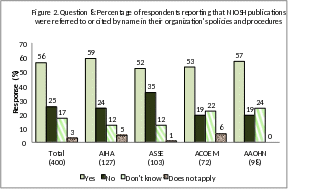
NIOSH and Organizations’ Safety and Health Practices (Question 9)
Question 9 was designed to assess to what extent respondents’ organizations’ safety and health practices have been influenced by NIOSH’s OSH information. Nearly half of the respondents (44%) reported that NIOSH’s OSH influenced their organization’s health and safety practices a lot, 45% reported a little, and 3% reported not at all. These responses reflect improvement over the baseline survey, indicating that outreach efforts are positively influencing respondents’ organizations’ safety and health practices. In response to the same question in 2003, 36% reported a lot, 44% a little, 3% not at all, and 17% did not know. These data are presented in Figure 3 in total and by association.
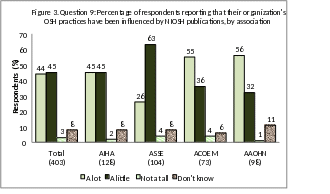
Quality of NIOSH Information for Organization and Professional Practice (Questions 10 and 11)
Respondents were asked to rate the quality of NIOSH information and/or training on a scale of Excellent to Poor as it contributes to the effectiveness of their organizations’ safety and health program (Question 10) and their professional practice (Question 11). Questions 10 and 11 were new measures in the follow-up survey. The results indicate that NIOSH information is most frequently rated as good (52%-53%) as it contributes to effectiveness of organizational health and safety programs and professional practice.
Table 8. Question 10 and 11: Quality of NIOSH Information and/or Training as it Contributes to Effectiveness
Rating |
% Respondents |
Organization’s Safety and Health Program: |
|
Excellent |
33 |
Good |
52 |
Fair |
7 |
Poor |
1 |
Don’t Know |
8 |
Your Professional Practice: |
|
Excellent |
37 |
Good |
53 |
Fair |
6 |
Poor |
1 |
Don’t Know |
4 |
Determining How Frequently NIOSH Publications and its Web Site are Used (Question 12)
Question 12 used a frequency scale with four levels to assess the usage of NIOSH publications and information services over the past 12 months. Each level included a numerical value to ensure consistency. The levels were defined as follows: frequently (>10), occasionally (3–10), rarely (1-2), and never (0). Table 9 represents a comparison of 2009 and 2003 responses. Figures
4 through 9 depict responses, by association, to survey questions 12a, 12b, 12c, 12d, 12e, and 12f. These results reflect printed source usage decreasing and electronic resource usage increasing, with 74% of respondents using the NIOSH website to find OSH information frequently (34%) or occasionally (40%). However, the results suggest low usage of the NIOSH eNews, with 46% never accessing it and 24% rarely. Participants further indicated a low rate (77% combined rarely and never) of attending educational/training programs where NIOSH publications were used as an information source.
Table 9. Question 12: Frequency of Performing the Following Tasks Within the Past 12 Months
Frequency |
% Respondents |
|
Used NIOSH printed publications to find OSH information: |
2009 |
2003 |
Frequently (>10 times) |
20 |
24 |
Occasionally (3-10 times) |
40 |
44 |
Rarely (1-2 times) |
35 |
27 |
Never (0 times) |
6 |
5 |
Used the NIOSH Web site to find OSH information: |
2009 |
2003 |
Frequently (>10 times) |
34 |
32 |
Occasionally (3-10 times) |
40 |
36 |
Rarely (1-2 times) |
21 |
25 |
Never (0 times) |
4 |
7 |
Opened or downloaded the NIOSH eNews: |
2009 |
|
Frequently (>10 times) |
13 |
|
Occasionally (3-10 times) |
18 |
|
Rarely (1-2 times) |
24 |
|
Never (0 times) |
46 |
|
Recommended a NIOSH publication, CD-ROM, or material from the NIOSH Web site to a colleague: |
2009 |
2003 |
Frequently (>10 times) |
9 |
10 |
Occasionally (3-10 times) |
33 |
29 |
Rarely (1-2 times) |
37 |
37 |
Never (0 times) |
21 |
24 |
Took a course/internet seminar or attended an education/training program in which NIOSH publications were used as information materials: |
2009 |
|
Frequently (>10 times) |
2 |
|
Occasionally (3-10 times) |
21 |
|
Rarely (1-2 times) |
42 |
|
Never (0 times) |
35 |
|
Frequency |
% Respondents |
|
Used technical information in scientific journals, books or conference proceedings that was authored by NIOSH researchers or NIOSH technical experts: |
2009 |
|
Frequently (>10 times) |
14 |
|
Occasionally (3-10 times) |
35 |
|
Rarely (1-2 times) |
35 |
|
Never (0 times) |
16 |
|
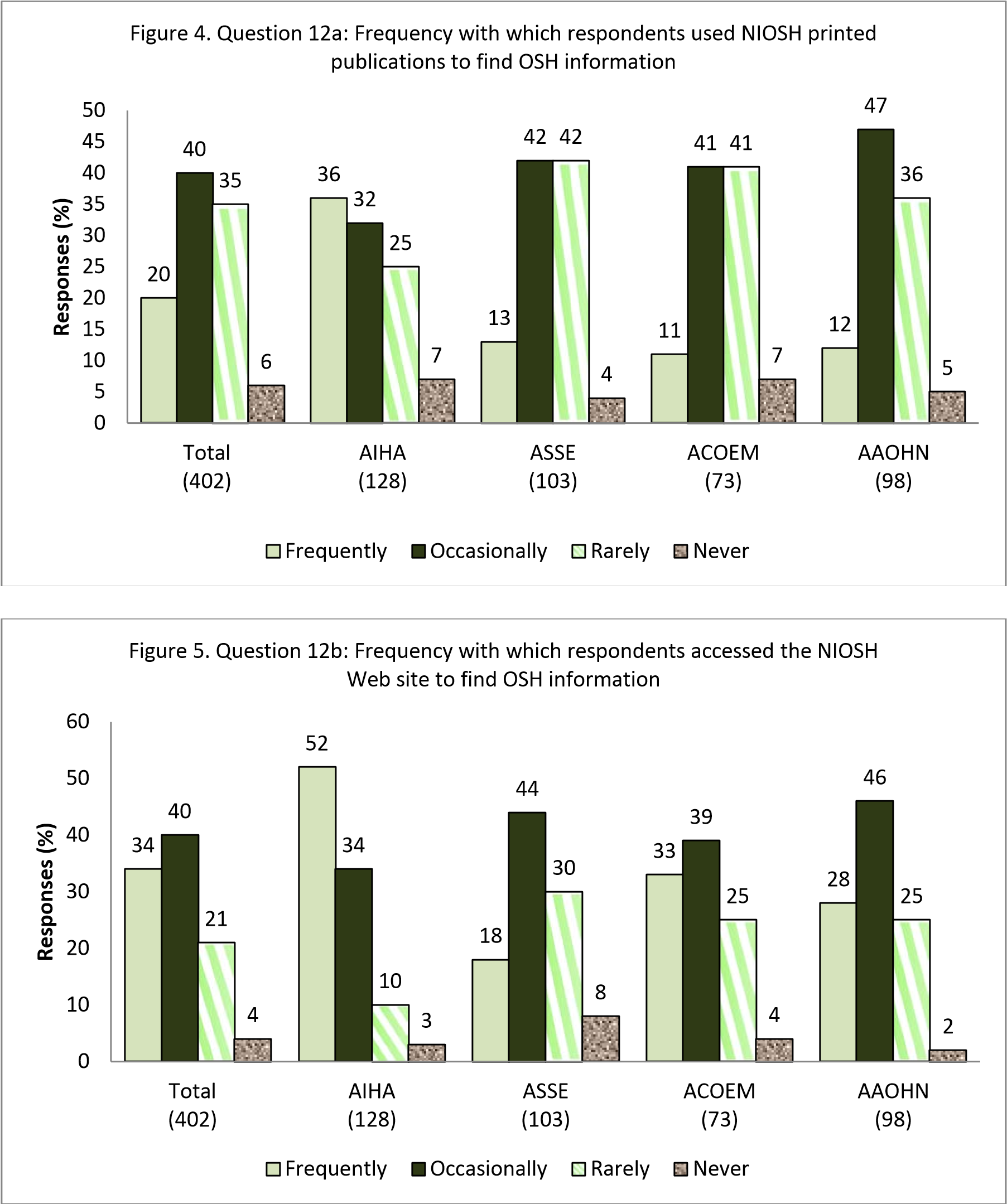
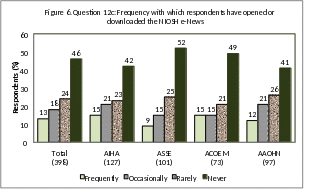
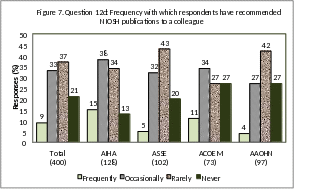
Figure 8. Question 12e: Frequency with which respondents have taken an educational/training program in which NIOSH publications were used
(399) (127) (103) (72) (97)
|
Figure 9. Question 12f: Frequency with which respondents have used technical information in scientific journals, books or conference proceedings that was authored by NIOSH researchers
(401) (128) (103) (73) (97)
|
Primary Job Responsibilities for Respondents (Question 13)
Respondents were given a list of 12 activities and asked to indicate which activities represent their three primary job responsibilities. For each of the three primary responsibilities selected, respondents were asked if they referred to any of NIOSH’s sources of information when performing the activity in the last 12 months. Since multiple responses were allowed, the data in the responses in Question 13 are best interpreted as a rank order score. Table 10 shows the percentage of respondents selecting the job responsibility that referred to NIOSH as an information source, as well as a comparison of the responses to the baseline survey. Figure 10 represents the responses from survey questions 13a, 13b, 13c, 13j, and 13k. The respondents who most frequently referred to NIOSH for their primary job duties were responsible for assessing workplace safety and health exposure conditions, formulating new or revised OSH policy/practices, developing/conducting research products, conducting OSH training, and establishing OSH programs.
Table 10. Question 13: Primary Job Responsibilities of Respondents and Referring to
NIOSH as a Source of Information
Job Responsibility |
% Respondents Primary Job Responsibility* |
% Respondents Referring to NIOSH |
||
|
2009 |
2003 |
2009 |
2003** |
Establishing and/or maintaining occupational safety and health programs |
43 |
52 |
81 |
47 |
Assessing workplace safety and health exposure conditions |
36 |
35 |
85 |
46 |
Interpreting/applying/enforcing OSHA regulations |
29 |
41 |
70 |
NA |
Providing medical treatment |
27 |
36 |
55 |
NA |
Conducting occupational safety and health training*** |
25 |
61 |
82 |
51 |
Conducting workplace safety audits and inspections |
21 |
37 |
53 |
32 |
Formulating new/revised safety and health policies/practices |
20 |
31 |
84 |
46 |
Maintaining medical records |
19 |
25 |
39 |
NA |
Investigating occupational safety & health incidents |
17 |
25 |
61 |
NA |
Designing/implementing hazard control measures |
14 |
18 |
74 |
39 |
Participating in emergency/disaster response or preparing emergency/disaster response written programs |
11 |
n/a |
70 |
NA |
Developing/conducting research projects |
7 |
6 |
84 |
21 |
* Original baseline survey allowed respondents to choose up to 5 job responsibilities, 2009 follow up survey only allowed for 3 primary job responsibilities
** Original baseline survey answer format was rank order (frequently, occasionally, rarely, never, not applicable). For the purpose of comparison, the 2003 responses frequently and occasionally have been combined to reflect a ‘Yes’ category. Items listed as “NA” (not applicable) were not assessed in the related baseline question.
*** Percentage in 2003 column represents combined responses of “Conduct worker OSH training” and “Conduct professional level OSH training” from baseline survey.
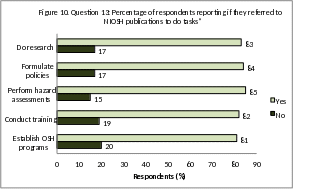
*2003 question was rank order (frequently, occasionally, rarely, never, NA) and 2009 only offered a Yes/No format.
SECTION III: OPINIONS ABOUT NIOSH AND ITS COMMUNICATION PRODUCTS
Question 14 consisted of 10 statements about NIOSH and its communication products. To assess these items, a five-point Likert rating scale was used. The scale provided four levels of agreement (i.e., strongly agree, agree, disagree, strongly disagree) and a no opinion option. Figures 11 through 16 present responses by association to survey question 14 subquestions. Figure 17 depicts responses to Questions 14g-14j. NIOSH continues to receive strong support from respondents, with a consistent increase in the percentage of respondents strongly agreeing that NIOSH produces publications that are up-to-date, impartial, at the appropriate technical level, and provide useful and practical information. NIOSH continues to be perceived as a credible source for obtaining OSH information, showing a slight increase in respondents who strongly agree with this statement. As noted earlier, the chart indicates a lack of awareness of eNews, with 53% having no opinion. NIOSH continues to be seen as an important resource for the OSH community, but with a slight decrease in respondents strongly agreeing with this statement.
Table 11. Question 14: Opinions About NIOSH and its Communication Products
|
|
% Respondents |
|
|
||||||
Statement |
Strongly Agree |
Agree |
Disagree |
Strongly disagree |
No Opinion |
|||||
|
2009 |
2003 |
2009 |
2003 |
2009 |
2003 |
2009 |
2003 |
2009 |
2003 |
a. NIOSH is a credible source for obtaining OSH information |
73 |
71 |
27 |
28 |
0 |
0 |
0 |
0 |
0 |
1 |
|
% Respondents |
|||||||||
Statement |
Strongly Agree |
Agree |
Disagree |
Strongly disagree |
No Opinion |
|||||
|
2009 |
2003 |
2009 |
2003 |
2009 |
2003 |
2009 |
2003 |
2009 |
2003 |
b. NIOSH eNews keeps me informed about OSH current events and research findings* |
10 |
NA |
32 |
NA |
4 |
NA |
1 |
NA |
53 |
NA |
c. The NIOSH Web site contains highquality, usable information |
42 |
38 |
47 |
49 |
2 |
1 |
0 |
0 |
10 |
12 |
d. The NIOSH/CDC 800-Number provides highquality, usable information |
7 |
8 |
18 |
27 |
2 |
1 |
0 |
0 |
73 |
64 |
e. The NIOSH exhibits at conferences keep me informed about new NIOSH publications and services |
14 |
15 |
39 |
42 |
8 |
3 |
2 |
1 |
37 |
39 |
f. NIOSH is an important resource for the OSH community |
57 |
65 |
40 |
32 |
1 |
0 |
1 |
0 |
2 |
3 |
g. NIOSH publications contain current, upto-date information |
39 |
30 |
49 |
62 |
7 |
3 |
1 |
0 |
5 |
5 |
h. NIOSH publications are impartial |
29 |
21 |
52 |
59 |
4 |
6 |
1 |
0 |
14 |
14 |
i NIOSH publications are at the appropriate technical level |
34 |
24 |
57 |
68 |
3 |
2 |
0 |
0 |
6 |
6 |
j. NIOSH publications provide useful recommendations and guidance |
40 |
29 |
56 |
63 |
1 |
3 |
0 |
0 |
3 |
5 |
*Question 14b not included in original baseline survey.
Figure 11. Question 14a: Percentage of respondents who agreed that NIOSH is a credible source for obtaining OSH information, by association
(404) (127) (103) (74) (100)
|
Figure 12. Question 14b: Percentage of respondents who agreed that NIOSH eNews keeps them informed about OSH current events, by association
(403) (127) (103) (74) (99)
|
Figure 13. Question 14c: Percentage of respondents who agreed that the NIOSH Web site contains high quality, usable information, by association
(405) (128) (104) (74) (99)
|
Figure 14. Question 14d: Percentage of respondents who agreed that the NIOSH/CDC 800-Number provides high quality , usable information, by association
(405) (128) (104) (73) (100)
|

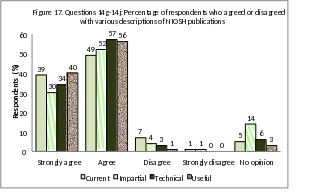
SECTION IV: RESPONDENT PREFERENCES AND RECOMMENDATIONS
Respondent Preference for Obtaining NIOSH Information (Question 15)
Respondents were provided with a list of five methods of obtaining NIOSH information as well as an other specify option. Respondents scored each method on a scale of 1 to 5, where 1 indicated a high preference for that method and 5 indicated a low preference. As shown in Table 12, 89% of respondents have a high preference for requesting and downloading information from the NIOSH Web site, 46% for obtaining compilations on CD-ROM, and 41% for access via NIOSH eNews. The most commonly listed items for those who provided a response in the “other” category were “printed materials through the mail” and “telephone call with NIOSH employees.” Figures 18, 19, and 20 represent a comparison of 2003 and 2009 responses. Figure 21 depicts responses by association.
Table 12. Question 15: Preferred Methods of Obtaining NIOSH Information
|
Distribution of Respondents’ Ratings (%) |
||||
|
High |
|
|
|
Low |
Statement |
1 |
2 |
3 |
4 |
5 |
a. Request and/or download from NIOSH Web site |
70 |
19 |
8 |
2 |
2 |
b. Call NIOSH/CDC 800-Number |
5 |
10 |
24 |
24 |
38 |
c. Obtain conference topic/literature compilations on CD-ROM |
13 |
33 |
27 |
15 |
13 |
d. Request at NIOSH conferences or exhibits |
6 |
20 |
28 |
21 |
25 |
e. Access via NIOSH eNews links |
17 |
24 |
26 |
16 |
17 |
f. Other |
16 |
8 |
4 |
1 |
72 |
Figure 18. Question 15a: Request and/or download from NIOSH Web site
70 60 50 40 30 20 10 0 1 2 3 4 5 High Preference Low Preference
|
||||||||||||||||||||||||
Figure 19. Question 15b: Call NIOSH/CDC 800-Number
35 30 25 20 15 10 5 0 1 2 3 4 5 High Preference Low Preference
|
||||||||||||||||||||||||||||||||||
35 30 
25 20 15 10 5 0 |
Figure 20. Question 15d: Request at NIOSH conferences or exhibit
1 2 3 4 5 High Preference Low Preference
|
||||||||||||||||||||||||||||||||||
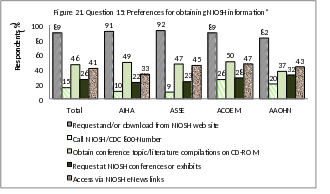
*Percentages reflect a combined total of an item being ranked 1 or 2, creating a general preference category.
Improving NIOSH dissemination of information (Question 16)
Question 16 provided a list of six statements, suggesting ways for NIOSH to improve its products and information delivery. Each statement included a five-point Likert scale. The scale ranged from 1 (a high value) through 5 (a low value). Respondents were asked to indicate a value for each suggested improvement. Spanish was the most often suggested language to make the publications available in, followed by several Asian languages (i.e. Chinese, Vietnamese, Korean). Table 13 indicates that respondents have a high preference for packaging and distributing NIOSH publications around common themes, publicizing and increasing the circulation of NIOSH Health Hazard Evaluation Reports, and disseminating information more through alliances with stakeholder partners. Figures 22 through 24 represent a comparison of 2003 and 2009 responses to survey questions 16a, 16b, and 16c.
Table 13. Question 16: Methods to Improve NIOSH Dissemination of Information
|
Distribution of Respondents’ Ratings (%) |
||||
|
High |
|
|
|
Low |
Suggestion |
1 |
2 |
3 |
4 |
5 |
a. Publicize and increase the circulation of NIOSH Health Hazard Evaluation Reports |
36 |
36 |
22 |
4 |
2 |
b. Package and distribute NIOSH publications around common themes (e.g., noise and hearing loss, ergonomic, agriculture) |
46 |
38 |
12 |
3 |
1 |
c. Make publications available in different languages |
8 |
9 |
21 |
16 |
47 |
d. Support a blog on the NIOSH Web site to discuss current science issues |
9 |
17 |
24 |
24 |
26 |
e. Promote the use of electronic social media (e.g., YouTube, MySpace, Wikipedia) for safety and health information |
8 |
15 |
23 |
23 |
32 |
f. Disseminate more through alliances with partners such as industry, labor, professional associations, trade associations, academia and other stakeholders |
21 |
43 |
26 |
7 |
4 |
Figure 22. Question 16a: Publicize and increase the circulation of NIOSH Health Hazard Evaluation Reports
40 35 30 25 20 15 10 5 0 1 2 3 4 5 High Low
|
||||||||||||||||||||||||||||||||
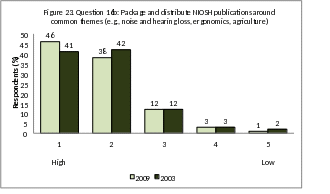
Figure 24. Question 16c: Make publications available in different languages
45 40 35 30 25 20 15 10 5 0 1 2 3 4 5 High Low
|
||||||||||||||||||||||||||||||||||||
New Safety and Health Topics for Future NIOSH Publications (Question 17)
Question 17 was an open-ended question in which the respondents were asked to list three new safety and health topics that NIOSH should address in future publications. The responses are organized/catalogued by subject matter. The results are shown in Table 14 for the 8 most popular topics in order of frequency. Workplace safety was cited most frequently (108 respondents) as a future publication topic, with injury and accident prevention, materials/equipment handling and safety, behavioral health and safety, transportation standards and safety, health care workplace safety, and confined space safety as recurring subcategories. Health effects and exposure related topics were listed an equal number of times by respondents, with 76 responses for each. The exposure related topics cited most frequently included noise safety (20 responses). Health effects topics included workplace diseases (communicable, influenzas, viruses), respiratory health, musculoskeletal disorder prevention and research, and cell phone health effects and safety.
Table 14. Question 17: Safety and Health Topics to Include in Future NIOSH Publications
New Safety and Health Topics |
Order of Most Frequent Listing |
Workplace safety |
1 |
Exposure related topics |
2 |
Health effects |
3 |
Safety research and best practices |
4 |
Employee health and well being |
5 |
Materials research and safety |
6 |
Nanotechnology |
7 |
Ergonomics |
8 |
Types of NIOSH Publications (Question 18)
Respondents were provided with a list of seven types of publications (information products) that NIOSH should consider emphasizing in the future. Respondents ranked their top three choices in order of importance. Since multiple responses were allowed, the data in Table 15 are best interpreted as a rank order score.
Table 15. Question 18: Types of Publications NIOSH Should Emphasize in the Future
Type of NIOSH Publication* |
% Respondents |
|
|
2009** |
2003 |
Practical applications/guides (checklists, audits, how to publications) |
62 |
81 |
Recommended safety and health standards |
55 |
72 |
Booklets or documents for educating workers |
38 |
67 |
Booklets or documents for educating owners/managers |
29 |
55 |
Case Studies (HHEs and FACE) |
26 |
51 |
Scientific/technical documents |
22 |
41 |
Manual of analytical methods |
13 |
35 |
* 2009 results only reflect respondent’s top 3 choices, whereas 2003 results allowed respondents to select as many publications as they liked. **Percentages reflect combined total of an item being ranked 1, 2, or 3, creating a general preference category.
Occupational and Health Research Topics for NIOSH in the Future (Question 19)
Question 19 provided a list of four potential occupational health research topics for NIOSH to focus on in the future and asked respondents to rank their top three choices in order of importance. Since multiple responses were allowed, the data in Table 16 are best interpreted as a rank order score. As indicated in Table 16, investigating associations between workplace exposure and disease was the most common research topic indicated by respondents.
Table 16. Question 19: Occupational and Health Research Topics for Future Focus
Occupational Health Research Topics for Future Focus* |
% Respondents |
Investigating associations between workplace exposures and disease |
67 |
Identifying early indicators of work-related disease (sentinel health events) |
63 |
Identifying controls for various exposures |
52 |
Developing screening tests to identify early occupational disease |
48 |
Investigating the pathophysiological basis for disease |
18 |
*Percentages reflect combined total of an item being ranked 1, 2, or 3 (no weight given to rank).
Occupational Safety and Health Problems Requiring Research (Question 20)
Question 20 was an open-ended question in which the respondents were asked to list three occupational safety and health problems that deserve more research. The responses are organized/catalogued by subject matter. The results are shown in Table 17 for the 8 most popular topics in order of frequency. 120 respondents listed exposure related topics for future research.
Recurring subcategories included noise safety, mold and allergens, and biological/chemical exposure. Workplace safety followed as second most frequent listing (76 responses), with injury and accident prevention and behavioral health and safety being cited most frequently.
Table 17. Question 20: Occupational Safety and Health Problems Requiring more Research
Occupational Safety and Health Problems |
Order of Most Frequent Listing |
Exposure related topics |
1 |
Workplace safety |
2 |
Ergonomics |
3 |
Safety research and best practices |
4 |
Workplace related illness |
5 |
Employee health and well being |
6 |
Health effects |
7 |
Nanotechnology |
8 |
SECTION V: NIOSH AS A RESEARCH PARTNER
Awareness and Importance of NIOSH Partnership Initiatives (Questions 21, 22, 23, and 24)
Respondents were provided with a list of four NIOSH initiatives developed over the last decade to build on and extend NIOSH partnerships with diverse stakeholders. Respondents ranked the importance of each initiative to them in their profession on a scale of very important (1) to not at all important (4). A not familiar category was provided for respondents unaware of the initiative. As shown in Table 18, there was a consistent lack of awareness of the respondents’ familiarity with the initiatives, ranging from 22% to 37% across the four initiatives. The National Occupational Research Agenda (NORA) received the lowest rankings in importance, with 27% of the respondents ranking it as 3 or 4 on the scale and 37% reporting that they were not familiar with it.
Table 18. Questions 21-24: Awareness and Importance of Four New NIOSH Initiatives
|
Distribution of Respondents’ Ratings (%) |
||||
|
Very Important |
|
|
Not at all Important |
Not Familiar |
Statement |
1 |
2 |
3 |
4 |
5 |
21. The National Occupational Research Agenda (NORA) provides an opportunity for stakeholders to have input into NIOSH’s research program. |
13 |
23 |
20 |
7 |
37 |
22. The NIOSH Research to Practice (r2p) initiative translates research results into information and documents that can be more readily used by practitioners. |
27 |
32 |
12 |
3 |
26 |
|
Distribution of Respondents’ Ratings (%) |
||||
|
Very Important |
|
|
Not at all Important |
Not Familiar |
23. The NIOSH WorkLife initiative provides information and support for the concepts that “healthy living and lifestyles” are also important to reduce and prevent chronic disease. |
28 |
26 |
16 |
6 |
24 |
24. The NIOSH Prevention through Design (PtD) initiative provides information and focuses on the need to design work and all work related tools with the goal of minimizing risk. |
33 |
29 |
13 |
3 |
22 |
Impact of NIOSH Partnerships on Occupational Safety and Health Community (Question 25)
Question 25 asked respondents to indicate their level of agreement (i.e., strongly agree, agree, disagree, strongly disagree, no opinion) with the following statement: NIOSH’s impact on the occupational safety and health community has been strengthened as a result of its partnerships with professional, academic, labor, and business organizations. An overwhelming 83% of respondents agreed with this statement.
New Topic Areas or OSH Initiatives for NIOSH Initiatives (Question 26)
Question 26 was an open-ended question in which the respondents were asked to list topic areas or OSH initiatives that NIOSH should include in their initiatives (i.e., NORA, r2p, WorkLife, or PtD). The responses are organized/catalogued by subject matter. The results are shown in Table 19 for the 8 most popular topics in order of frequency. The most commonly suggested initiative was employee health and well being (19 respondents), with work life balance consistently cited within this category. General workplace safety was the second most frequently listed initiative, with injury and accident prevention the most common subcategory. Additional work place safety topics included certification and selection of personal protective gear, creating a culture of safety, behavior based safety, and emergency planning.
Table 19. Question 26: Topics Areas that Should be Included in NIOSH Initiatives
New Topic Areas or OSH Initiatives |
Order of Most Frequent Listing |
Employee health and well being |
1 |
General workplace safety |
2 |
Exposure related topics |
3 |
Materials topics |
4 |
Industry specific safety issues |
5 |
Aging workforce |
6 |
Ergonomics |
7 |
Nanotechnology |
8 |
Stakeholder for NIOSH Initiatives (Question 27)
Question 27 was an open-ended question in which the respondents were asked to list stakeholders that NIOSH should partner with through the NORA, r2p, WorkLife, or PtD initiatives. The 144 responses were organized by stakeholder group and the results are shown in Table 20 for the 8 most popular topics in order of frequency. Medical associations and societies were cited most frequently by the respondents (26 responses), with the American Association of Occupational Health Nurses (AAOHN) listed the most and the American College of Occupational and Environmental Medicine (ACOEM) following in frequency. Government agencies followed in suggested stakeholder partnership (22 respondents), with OSHA being listed with the most frequency.
Table 20. Question 27: Stakeholders NIOSH Should Partner with Through Their Initiatives
Stakeholders for NIOSH Initiatives |
Order of Most Frequent Listing |
Medical associations/societies |
1 |
Government agencies |
2 |
Corporations and industry |
3 |
Engineering associations |
4 |
Professional hygienist organizations |
5 |
Materials associations |
6 |
Standards and safety associations |
7 |
University and academic institutions |
8 |
4. CONCLUSIONS
The demographic characteristics of the respondents were similar to the 2003 baseline survey. The four most common occupations were industrial hygienist, nurse, physician, and industrial safety engineer. Most of the respondents worked in large companies or businesses and performed a range of jobs that included establishing and conducting OSH programs, interpreting and applying OSHA regulations, and conducting training and workplace safety audits and inspections. The most common sectors the participants worked in were manufacturing, healthcare and social assistance, construction and transportation, warehousing, and utilities. As to be expected with increased dependence on electronic resources, respondents relied more on electronic sources for OSH information on a daily basis (+9%) and printed sources decreased usage on a daily basis (-15%) as compared to the baseline survey. Participants also increased their daily and weekly usage (+11%) of interpersonal sources, such as colleagues, experts, meetings, and conferences. Additionally, an increase was seen in the respondents using the NIOSH web site to find OSH information. This increase was uniform across associations, except for ASSE respondents, who indicated a 17% decrease in frequency of using the web site. This general increase could be a reflection of successful outreach initiatives and revisions to the NIOSH website.
The respondents continued to refer to NIOSH and OSHA as their two main sources for OSH information. Other highly ranked sources included AAOHN and ACOEM, differing from the baseline survey’s high ranking of ANSI and ACGIH. Fluctuations of rankings and a general decrease in association percentages could be attributed to an altered question structure in the follow-up survey. The participants were restricted to selecting three organizations in the followup survey, whereas the baseline survey had no limit to the amount of organizations selected.
NIOSH continues to meet the information needs of the respondents and their corresponding OSH professional associations, displaying a slight increase in NIOSH publication reference and usage since 2003. Eighty-two percent (82%) of the survey participants had used or referred to a NIOSH publication, which represents a very slight increase (2%) from 2003. Within associations, there has been increased usage by ACOEM (+5%) and AAOHN (+13%) and a decrease by AIHA (-6%). Survey responses indicate that NIOSH publications are being utilized with more frequency by the respondents and their workplaces. Nearly 56% of the respondents reported that NIOSH materials had been used or cited by name in their organization’s policies and procedures, representing a 6% increase from 2003. Additionally, participants responded that NIOSH information materials had influenced their organization’s safety and health practices either a lot (44%) or a little (45%). Notably, the 44% choosing a lot represents an 8% increase from 2003. Increases in NIOSH publications influencing organization OSH practices and being referred to in organization policy and procedures were consistent across professions.
Similar to the original survey, the respondents gave NIOSH a 100% grade for being a credible source of OSH information, showing a marginal increase in participants strongly agreeing with this statement. Members of the AIHA, ACOEM, and AAOHN showed an increase in respondents strongly agreeing with this statement, with ACOEM displaying the strongest value increase (+14%). Conversely, members of the ASSE showed a decrease in supporting this statement strongly (-10%). Respondents continued to agree with the statement that NIOSH is an important resource for the OSH community; 97% strongly agreed or agreed with the statement. This follow-up percentage matched the original 2003 percentage of those who strongly agreed or agreed, but within these numbers there was a decrease in respondents choosing strongly agree (7%) and an increase in respondents choosing agree (+8%). Within associations, AAOHN was the only association that had an increase in strongly valuing NIOSH in the OSH community (+6%). The cause of this general decrease in strongly valuing NIOSH as an important resource is something that needs to be further explored. Respondents continued to strongly agree that NIOSH produces publications that are up-to-date, impartial, at the appropriate technical level, and provide useful and practical information, with a consistent increase in the percentage of respondents that strongly agreed.
Among the respondents that had ever used or referred to a NIOSH publication, respondents continued to refer to NIOSH materials when performing their job tasks. The respondents who most frequently referred to NIOSH for their primary job duties were responsible for assessing workplace safety and health exposure conditions, formulating new or revised OSH policy/practices, developing/conducting research products, conducting OSH training, and establishing OSH programs. The respondents who referred the least to NIOSH publications were responsible for maintaining medical records. There was a substantial increase in referring to NIOSH across job responsibilities; however, these increases may be an artifact of the revised question and response format. This question was revised in the follow-up survey, allowing for the respondents to identify only three primary job tasks and a yes/no answer format if they referred to NIOSH for their identified job duties.
The follow-up survey assessed customer preferences for future information products and previous outreach efforts. Respondents continued to be supportive of emphasizing information that provides practical and clear guidance on matters related to policy (i.e. criteria documents) and tools designed and packaged for more direct application, checklists, how-to, and self-audits. Of interest are the reduced percentages seen for these items in the follow-up survey, indicating that initiatives and outreach post-baseline survey may have addressed respondents’ needs. However, percentage fluctuations could also be attributed to a revised question format.
The original baseline survey found that 21% of the respondents had never used or referred to NIOSH materials and the follow-up survey showed a marginal decrease, with 18% of the respondents never using or referring to NIOSH materials. Similar to the original survey, this effect continued to be most prevalent among survey respondents who belonged to the two medical associations (ACOEM and AAOHN). These findings indicate that a subset of the OSH community, specifically the OSH medical population, has not been fully engaged by NIOSH’s outreach efforts and initiatives.
The follow-up study assessed the respondents’ opinions of NIOSH’s new initiatives with diverse stakeholders such as academia, industry, labor unions, and nonprofits. The respondents favorably supported (83% strongly agree/agree) efforts made in developing partnerships with stakeholders and believed these partnerships strengthened NIOSH’s impact on the OSH community. Of the four partnership initiatives, Research to Practice (r2p), Worklife, and Prevention through Design
(PtD) all received higher importance rankings and were identified as having value to respondents. The National Occupation Research Agenda (NORA) received the lowest rankings in importance, with 27% ranking it third or fourth and only 13% rating it as very important. Additionally, 37% of the respondents reported not being familiar with the initiative. Lack of NORA awareness and value in the OSH community needs to be explored further. Across the four
initiatives, there was a consistent lack of awareness, ranging from 22% to 37%, by the respondents. This indicates that more effort needs to put into publicizing and disseminating partnership initiatives.
5. FUTURE ACTIONS
NIOSH continues to be perceived as a credible source for obtaining OSH information that provides high-quality, usable information. Marginal improvements were seen in support of this statement which can likely be attributed to initiatives and outreach efforts. The decrease of participants strongly agreeing with NIOSH as an important resource for the OSH community needs to be further explored. Additionally, NIOSH needs to continue to expand its outreach to the 18% of respondents who have not used NIOSH materials, with a continued focus towards increasing outreach to the occupational health service sectors. Partnering with professional organizations to better identify who these OSH members are and performing needs assessments of this subset could be useful for integrating them into the NIOSH community.
NIOSH partnership initiatives have generally been well received and are perceived as strengthening NIOSH’s presence in the OSH community. Respondents reported that through initiatives such as NORA, r2P, WorkLife, and PtD, partnerships should be created with medical association and societies, government agencies, and corporations. An increased focus needs to be put into outreach efforts focused on those who are still unaware of these initiatives. Special consideration should be given to examining respondents’ lack of familiarity with NORA. Furthermore, respondents put high value on information being disseminated more through diverse stakeholder partners.
NIOSH information and training were generally endorsed as contributing to the effectiveness of individuals’ professional practices, as well as organizations’ safety and health practices. The great majority of respondents rated information and training as it contributes to the effectiveness of their organization’s safety and health program as excellent (33%) or good (52%). Similarly, respondents rated information and training as contributing to the effectiveness of their professional practice as excellent (37%) or good (53%). Future research could include better quantifying which information and training services are contributing to the perceived effectiveness and usefulness by organizations and individuals. Findings would facilitate a stronger focus on customer needs and result in a higher excellence rating in future studies.
More effort needs to be put into outreach for the NIOSH eNews. Over the last 12 months 46% respondents had never used this resource, 24% rarely used it, and 31% used it frequently or occasionally. However, 42% of the respondents agreed that NIOSH eNews keeps them informed about OSH current events and research findings. This suggests that additional outreach is needed to increase awareness, as eNews is displaying high value and usefulness to the population who actually uses it.
Respondents indicated a desire to see more research generated on work place exposure and disease, identifying early indicators of work-related disease, identifying controls for various exposures, and ergonomics. Similarly, respondents identified workplace safety, exposure related topics, and health effects, and employee health and well being as new safety and health topics and initiatives for the near future.
In conclusion, the follow-up survey provided valuable information about the strengths of the post-baseline outreach efforts and areas for future focus. NIOSH has made several marked improvements in customer satisfaction since the baseline survey, but still needs to focus on developing and improving in several areas. The findings of the survey provide guidance for NIOSH staff to investigate the identified areas of weakness and formulate targeted research questions in the future. Finally, these findings provide NIOSH the tools to develop and improve their customer satisfaction in future NIOSH services and communications to the OSH community.
APPENDIX
Response Summary Questionnaire
SECTION I
BACKGROUND - TELL US ABOUT YOURSELF
How would you define your professional training/background?
Please mark () all that apply.
20% - Physician
19% - Industrial safety engineer
24% - Nurse
28% - Industrial hygienist 16% - Other (Specify):
In your CURRENT job, what type of organization do you work for?
Please mark ()) all that apply.
44% - Company/business
0% - Labor organization
3% - Industry or trade association
19% - Hospital/clinic
14% - Private consultant
0% - Professional society staff
13% - Federal/State/Local government agency 12% - Other (Specify):
In your current job, how would you classify the overall size of the organization in which you work?
Please mark () one response.
8% - Self only
14% - Small (less than 100 employees)
12% - Medium (101 to 500 employees)
66% - Large (more than 500 employees)
In your current job, in which of the following sectors do you work and/or apply your professional skills? Please mark () all that apply.
8% - Agriculture, forestry, and fishing
30% - Construction
41% - Healthcare and social assistance
12% - Mining | Oil and gas extraction
48% - Manufacturing
27% - Services
30% - Transportation, warehousing, and utilities
13% - Wholesale and retail trade
23% - Other (Specify)
SECTION II
YOUR SOURCES FOR OCCUPATIONAL SAFETY AND HEALTH INFORMATION
In your current job, how often do you use the following sources of occupational safety and health (OSH) information? Please mark () one response for EACH source.
Printed Sources Electronic Sources Interpersonal Sources
e.g., books, journals, e.g., Web search, e.g., colleagues, experts,
tech reports CD-ROMs, software meetings, conferences
19% - Daily 50% - Daily 30% - Daily
36% - Weekly 30% - Weekly 33% - Weekly
25% - Monthly 14% - Monthly 23% - Monthly
21% - Less than monthly 7% - Less than monthly 14% - Less than monthly
Please select the three organizations that provide the most important occupational safety and health (OSH) information (via the web or printed) for your job. Please mark () up to THREE (3) responses.
24% - AAOHN American Association of Occupational Health Nurses
17% - ACGIH American Conference of Governmental Industrial Hygienists
21% - ACOEM American College of Occupational and Environmental Medicine
16% - AIHA American Industrial Hygiene Association
13% - ANSI American National Standards Institute
17% - ASSE American Society of Safety Engineers
7% - ATSDR Agency for Toxic Substances and Disease Registry
9% - EPA Environmental Protection Agency
12% - NFPA National Fire Protection Agency
57% - NIOSH National Institute for Occupational Safety and Health
4% - NSC National Safety Council
76% - OSHA Occupational Safety and Health Administration
3% - Trade Organizations
0% - Labor Organizations
10% - Commercial newsletters, magazines, publications, etc. (Specify):
The following questions pertain to your organization's use of NIOSH’s occupational safety and health (OSH) information/publications/website.
Have you ever USED or REFERRED to NIOSH’s OSH information?
(i.e., from a NIOSH publication, NIOSH web site, NIOSH e-News, CD-ROM, or
NIOSH/CDC 800-Number)
82% - Yes IF "YES" CONTINUE TO QUESTION 8
18% - No IF "NO" GO TO SECTION V (Page 8)
Has NIOSH’s OSH information—either from their documents or the NIOSH Web site—been referred to or cited by name in your organization's policy and procedures? Please mark () one response.
56% - Yes
25% - No
17% - Don't know
3% - Does not apply - no written OSH policy and procedures
To what extent have your organization's safety and health practices been influenced by NIOSH’s OSH information, either from their documents or from NIOSH’s Web site? Please mark () one response.
44% - A lot
45% - A little
3% - Not at all
8% - Don’t know
How would you rate the quality of NIOSH information and/or training as it contributes to the effectiveness of your organization’s safety and health program? Please mark () one response.
33% - Excellent
52% - Good
7% - Fair
1% - Poor
8% - Don’t know
How would you rate the quality of NIOSH information and/or training as it contributes to the effectiveness of your professional practice? Please mark () one response.
37% - Excellent
53% - Good
6% - Fair
1% - Poor
4% - Don’t know
Please indicate the frequency that you performed each of the following tasks within the PAST 12 MONTHS.
Please mark () one response for EACH statement below.
STATEMENTS >Frequently 10 Times Occasionally 3-10 Times RarelyTimes1-2 0Never Times
Used NIOSH printed publications to
find OSH information. 20% 40% 35% 6%
Used the NIOSH Web site to find OSH
information. 34% 40% 21% 4%
Opened or downloaded the NIOSH e-
News 13% 18% 24% 46%
Recommended a NIOSH publication,
CD-ROM, or material from the NIOSH Web site to a colleague. 9% 33% 37% 21%
Taken a course/internet seminar or attended an education/training program in
which NIOSH publications were used as 2% 21% 42% 35% information materials.
Used technical information in scientific journals, books or conference proceedings that was authored by NIOSH 14% 35% 35% 16% researchers or NIOSH technical experts.
13. In your current job, which of the following activities best represent your 3 primary responsibilities? For each of your 3 primary responsibilities, please indicate whether or not you referred to any of NIOSH’s sources of information when performing this task during the past 12 months. (Sources: printed publications, CD-ROMs, NIOSH website, e-News)
Please mark () up to THREE (3) responses.
Activities
Mark If Referred to NIOSH if primary marked information source responsibility
Yes No
Establishing and/or maintaining
occupational safety and 43% 81% 19% health programs
Conducting occupational safety and
health training 25% 82% 19%
Assessing workplace safety and health
exposure conditions 36% 85% 15%
Maintaining medical records 19% 39% 61%
Conducting workplace safety audits and
inspections 21% 53% 47%
Investigating occupational safety & health
incidents 17% 61% 39%
Providing medical treatment 27% 55% 45%
Interpreting/applying/enforcing OSHA
regulations 29% 70% 30%
Designing/implementing hazard control
measures 14% 74% 26%
Formulating new/revised safety and
health policies/practices 20% 84% 17%
Developing/conducting research projects 7% 83% 17%
Participating in emergency/disaster
response or preparing 11% 70% 30% emergency/disaster response written programs.
SECTION III
YOUR OPINION ABOUT NIOSH AND ITS COMMUNICATION PRODUCTS
14. Please indicate how strongly you AGREE or DISAGREE with each of the following statements.
Please mark () one response for EACH statement below.
STATEMENTS StronglyAgree Agree Disagree disagreeStrongly OpinionNo
NIOSH is a credible source for obtaining
OSH information. 73% 27% 0% 0% 0%
NIOSH eNews keeps me informed about
OSH current events and research 10% 32% 4% 1% 53% findings.
The NIOSH Web site contains high-
quality, usable information. 42% 47% 2% 0% 10%
The NIOSH/CDC 800-Number provides
high quality, usable information. 7% 18% 2% 0% 73%
The NIOSH exhibits at conferences keep
me informed about new NIOSH 14% 39% 8% 2% 37% publications and services.
NIOSH is an important resource for the
OSH community. 57% 40% 1% 1% 2%
NIOSH publications contain current, up-
to-date information. 39% 49% 7% 1% 5%
NIOSH publications are impartial. 29% 52% 4% 1% 14%
NIOSH publications are at the appropriate
technical level. 34% 57% 3% 0% 6%
NIOSH publications provide useful
recommendations and guidance.
40% 56% 1% 0% 3%
SECTION IV
YOUR PREFERENCES AND RECOMMENDATIONS
15. Listed below are various methods of obtaining NIOSH information. Please indicate YOUR preference on a scale of 1 to 5 for each method of obtaining NIOSH documents, publications, or web site content, where "1" indicates a high preference for that method and "5" indicates a low preference.
Please mark () one response for EACH statement below.
High Low
STATEMENTS Preference Preference
1 2 3 4 5
Request and/or download from NIOSH
Web site 70% 19% 8% 2% 2%
Call NIOSH/CDC 800 -Number 5% 10% 24% 24% 38%
Obtain conference topic/literature
compilations on CD-ROM 13% 33% 27% 15% 13%
Request at NIOSH conferences or
exhibits 6% 20% 28% 21% 25%
Access via NIOSH eNews links 17% 24% 26% 16% 17%
Other (Specify): 16% 8% 4% 1% 71%
16. Listed below are suggested ways for improving NIOSH dissemination of information. Please indicate the value to YOU on a scale of 1 to 5 for each suggested improvement where "1" indicates a high value to you and "5" indicates a low value.
Please mark () one response for EACH statement below.
STATEMENTS
Publicize and increase the circulation of
High Low
Value Value
1 2 3 4 5
NIOSH Health Hazard Evaluation 36% 36% 22% 4% 2%
Reports.
Package and distribute NIOSH publications around common themes
(e.g., noise and hearing loss, ergonomics, 46% 38% 12% 3% 1% agriculture).
Make publications available in different
languages. (Specify languages): 8% 9% 21% 16% 47%
Support a blog on the NIOSH Web site to
discuss current science issues. 9% 17% 24% 24% 26%
Promote the use of electronic social media (e.g., YouTube, MySpace,
Wikipedia) for safety and health 8% 15% 23% 23% 32% information.
Disseminate more through alliances with partners such as industry, labor,
professional associations, trade 21% 43% 26% 7% 4% associations, academia and other stakeholders.
Please list THREE new safety and health topics that NIOSH should address in the near future.
 a.
a.
b.
c.
Which of the following types of publications should NIOSH consider emphasizing in the future? Please rank your top 3 choices in order of importance to you. Enter a "1" to indicate the most important topic, "2" for the second most important, and "3" for the third most important.
RANK
62% Practical applications and guides (e.g., checklists, self-audits, "how-to" publications)
55% Recommended safety and health standards (criteria documents)
38% Booklets or documents for educating and informing workers
29% Booklets or documents for educating and informing owners and managers
Case studies (e.g., Health Hazard Evaluations, fatality investigations, Research to
26% Practice (r2p) outcomes)
22% Scientific/technical documents
13% Manual of Analytical Methods
62% Practical applications and guides (e.g., checklists, self-audits, "how-to" publications)
Please rank the following occupational health research topics in order of importance to you as potential areas of focus for NIOSH in the future. Please rank your top 3 choices. Enter a "1" to indicate the most important topic, "2" for the second most important, and "3" for the third most important.
RANK
67% Investigating associations between workplace exposures and disease
63% Identifying early indicators of work-related disease (sentinel health events)
52% Identifying controls for various exposures
48% Developing screening tests to identify early occupational disease
18% Investigating the pathophysiological basis for disease
Please list the top THREE occupational safety and health problems that you think deserve more research.
 a.
a.
b.
c.
SECTION V
NIOSH AS RESEARCH PARTNER WITH ACADEMIA, INDUSTRY, LABOR UNIONS, NONPROFITS, AND OTHER DIVERSE STAKEHOLDERS
Over the last decade, NIOSH has developed several new initiatives that build on and extend NIOSH partnerships with diverse stakeholders. We are interested in your awareness of these new initiatives and your opinions about the importance of each.
Very Not at all Not
Important Important Familiar
1 2 3 4
The National Occupational Research Agenda (NORA) provides an opportunity for stakeholders to have input into
NIOSH’s research program. How 13% 23% 20% 7% 37% important is this initiative to you in your profession?
The NIOSH Research to Practice (r2p) initiative translates research results into information and documents that can be
more readily used by practitioners. How 27% 32% 12% 3% 26% important is this initiative to you in your profession?
The NIOSH WorkLife initiative provides information and support for the concepts that “healthy living and lifestyles” are also
important to reduce and prevent chronic 28% 26% 16% 6% 24% disease. How important is this initiative to you in your profession?
The NIOSH Prevention through Design (PtD) initiative provides information and focuses on the need to design work and
all work related tools with the goal of 33% 29% 13% 3% 22% minimizing risk. How important is this initiative to you in your profession?
Please indicate how strongly you AGREE or DISAGREE with the following statement.
StronglyAgree Agree Disagree disagreeStrongly OpinionNo
NIOSH’s impact on the occupational safety and health community has been
strengthened as a result of its 32% 51% 2% 1% 13% partnerships with professional, academic, labor, and business organizations.
Please list topic areas or OSH initiatives you would like to see included in NORA, r2p, WorkLife, or PtD initiatives.
Employee health and well being, general workplace safety, exposure related topics
Please list stakeholders you would like to see partner with NIOSH via the NORA, r2p, WorkLife, or PtD initiatives.
Medical associations/societies, government agencies, corporations and industry
SECTION VI FINAL COMMENTS
WE CARE ABOUT WHAT YOU THINK. Please use this space to provide us any additional comments you have about this survey or about the services and products provided by NIOSH.
THANK YOU FOR COMPLETING THE QUESTIONNAIRE!
Your help is greatly appreciated. Please take the following steps.
Place your questionnaire in the pre-paid envelope provided and seal it.
Fill out the enclosed Survey Response Card so we will know you’ve completed a survey.
Mail the questionnaire and Response Card separately to assure your anonymity.
Further information about the NIOSH outreach initiatives is available at the following links:
National Occupational Research Agenda (NORA): http://www.cdc.gov/niosh/nora
Research to Practice (r2p): http://www.cdc.gov/niosh/r2p
WorkLife: http://www.cdc.gov/niosh/worklife
Prevention through Design (PtD): http://www.cdc.gov/niosh/topics/ptd
2 Appendix includes a copy of the NIOSH Questionnaire with the survey responses.
3 For this survey, NIOSH publications were defined as any combination of NIOSH printed materials, NIOSH CDROMs, NIOSH Web site materials, or information from the NIOSH technical information inquiry service (800- Number and Fax line).
4 For this survey, NIOSH publications were defined as any combination of NIOSH printed materials, NIOSH CDROMs, NIOSH Web site materials, or information from the NIOSH technical information inquiry service (800- Number and Fax line).
5 McMahon S, Iwamoto M, Massoudi M, Yusuf H, Stevenson J, Da Chu S et al. Comparison of e-mail, fax, and postal surveys of pediatricians. Pediatrics 2003;111:299-303.
6 Dillman, D. (2000) Mail and Internet Surveys. New York: John Wiley & Sons, Inc.
| File Type | application/vnd.openxmlformats-officedocument.wordprocessingml.document |
| Author | Jaime Liesmann |
| File Modified | 0000-00-00 |
| File Created | 2021-01-21 |
© 2026 OMB.report | Privacy Policy
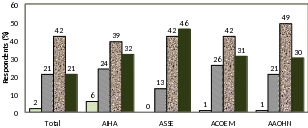
 Frequently
Frequently  Occasionally
Occasionally  Rarely
Rarely  Never
Never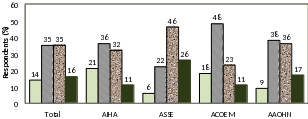
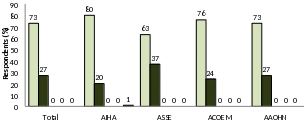
 Strongly agree
Strongly agree  Agree
Agree  Disagree
Disagree  Strongly disagree
Strongly disagree  No opinion
No opinion